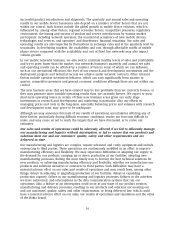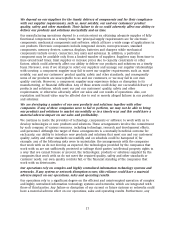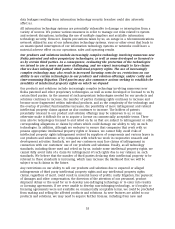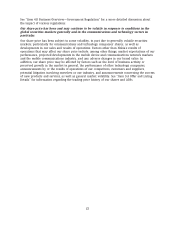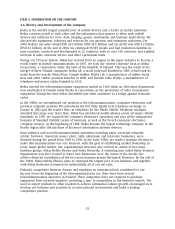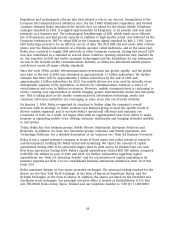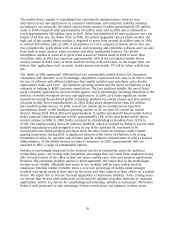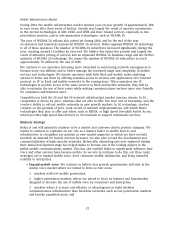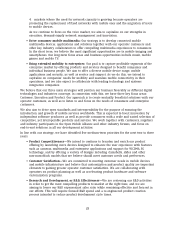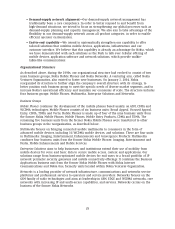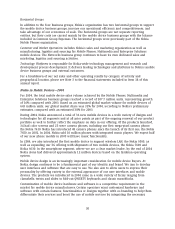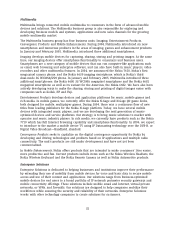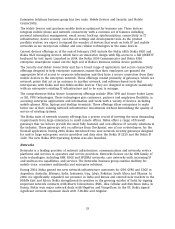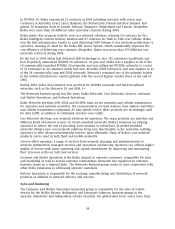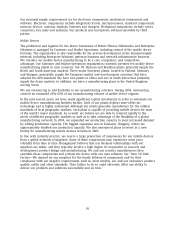Nokia 2004 Annual Report Download - page 27
Download and view the complete annual report
Please find page 27 of the 2004 Nokia annual report below. You can navigate through the pages in the report by either clicking on the pages listed below, or by using the keyword search tool below to find specific information within the annual report.The mobile device market is expanding from voice-based communications towards new,
data-driven areas and applications in consumer multimedia and enterprise mobility solutions.
According to our estimates, the global camera phone market reached approximately 215 million
units in 2004 compared with approximately 90 million units sold in 2003 and is estimated to
reach approximately 340 million units in 2005. Nokia has introduced 48 camera phones since the
launch of its first one, the Nokia 7650, in 2002. The global megapixel camera phone market, the
high end of the camera phone market, is expected to grow from around 40 million units in 2004
to around 100 million units in 2005. A smartphone is a new category of mobile device that can
run computer-like applications such as email, web browsing and enterprise software and can also
have built-in music players, video recorders and other multimedia features. The global
smartphone market is expected to grow from around 22 million units in 2004 to more than
50 million units in 2005 and represent approximately 25% of the total global mobile device
market volume in 2008. Some of these markets overlap with each other. In the longer term, we
believe that applications such as music, mobile games and mobile TV will be taken widely into
use.
The ability to offer segmented, differentiated and customizable mobile devices for consumers,
enterprises and operators is an increasingly competitive requirement. One way to do this is with
the use of software and software platforms that enable intuitive user interfaces and valuable
applications. Nokia sees Java, the Symbian operating system and the Series 60 Platform as key
elements in helping to fulfill customer expectations. The Java platform enables the use of third-
party consumer applications, such as mobile games, and is increasingly becoming important in the
delivery of mobile enterprise services and applications. In 2004, Java made significant strides
towards becoming the preferred global technology platform for mobile phones and was used by
all major mobile device manufacturers. In 2004, Nokia alone shipped more than 125 million
Java-enabled mobile devices. In 2004, several key mobile device manufacturers launched
smartphones based on the Symbian operating system, or OS, an open OS created for mobile
devices. During 2004, Nokia delivered approximately 12 million Symbian OS-based mobile devices.
Nokia estimates that smartphones will be approximately 25% of the total global mobile device
market volume in 2008. In 2004, Nokia increased its shareholding in Symbian from 32.2% to
47.9%. The market-leading Series 60 software platform, which is licensed by Nokia to several other
handset manufacturers and designed to run on top of the Symbian OS, continued to be
incorporated into Nokia products and those from the other Series 60 licensees, with volumes
gaining momentum during 2004. A significant element of the Series 60 Platform is its strong
foundation to allow for operator and end-user specific software customization as well as licensee
differentiation. Of the mobile devices we plan to announce in 2005, approximately 90% are
expected to offer a range of customizable options.
Mobility is increasingly important to the business market as enterprises assess the potential
productivity gains, cost savings and competitive advantages that can result from employees being
able to work outside of the office as they use secure mobile voice, data and business applications.
However, the enterprise mobility market is still fragmented. We expect that as the technologies
become more reliable, affordable and easier to use, mobility will be more widely used by
employees. External studies currently show a very low percentage of mobile email amongst
workers who spend much of their time on the move and who connect to their offices via a mobile
device. We expect this to become the lead application as businesses mobilize. In the coming years,
we believe that devices with multi-radio access and the addition of mobile elements to corporate
applications will be key drivers for establishing and extending mobility in enterprises. We believe
Nokia is well positioned to take advantage of these trends given our expertise in these areas.
26


